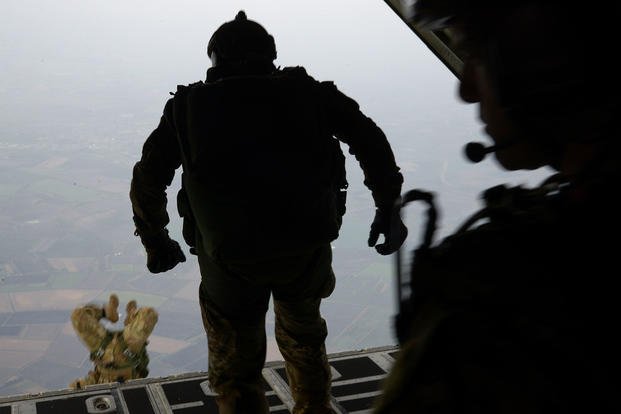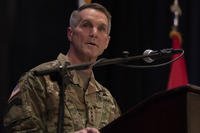The 352nd Special Operations Group is an essential part of the Air Force Special Operations Command based at RAF Mildenhall in the United Kingdom. The group has more than 700 Air Force personnel assigned, as well as nearly 50 personnel attached/associated as members of Joint Special Operations Air Component-Europe and Detachment 2, 25th Intelligence Squadron. The group is the only Air Force special operations unit in European Command.
Mission
Under the operational control of Special Operations Command Europe, the 352nd SOG plans and executes specialized and contingency operations using advanced aircraft, tactics and air refueling techniques to infiltrate, exfiltrate and resupply special operations forces. The unit has five squadrons and two different versions of MC-130 aircraft assigned and is managed administratively by AFSOC.
The group or its squadrons have deployed in support of Operations Desert Storm, Provide Comfort, Enduring Freedom, Iraqi Freedom, Provide Promise, Deny Flight, Allied Force, Assured Response, Silver Anvil, Atlas Response, Support Hope, Joint Endeavor, Deliberate Force, Guardian Light, Guardian Assistance, Shining Express, Autumn Return, Assured Delivery, Aster Silver and Enduring Freedom-Trans Sahara. Recently, the group spearheaded air-land operations for Joint Task Force-Lebanon, the evacuation of noncombatants from Chad and U.S. European Command support during the 2008 Russia-Georgia conflict. The group regularly is called upon to support special operations for OIF, OEF and OEF-TS as well as other overseas contingency operations.
Units
The 352nd Special Operations Support Squadron provides support for two flying squadrons, one special tactics squadron and one maintenance squadron for exercise, logistics and deployment planning; aircrew training; communications; aerial delivery; medical; intelligence; security and force protection; weather; information technologies and transformation support; and current operations.
The expeditionary design and flexibility of the 352nd OSS is showcased regularly and highlighted by its ability to operate simultaneously in up to four locations. The squadron's "can-do" attitude allows the group commander to focus on force application and project specialized combat air power in the EUCOM area of responsibility and elsewhere.
The 352nd Special Operations Maintenance Squadron provides all organizational maintenance on MC-130H and MC-130P aircraft assigned to the group's two special operations flying squadrons. It also provides management for the group's engine and munitions inventories.
The 7th Special Operations Squadron operates the MC-130H Combat Talon II, executing night, adverse weather, long-range insertion, extraction and resupply operations into hostile, denied or politically sensitive areas. The squadron also supports noncombatant evacuation, humanitarian relief and other special operations. The Combat Talon II uses a combination of terrain-following radar, high-precision avionics and sensors and electronic countermeasures.
The 67th Special Operations Squadron operates the MC-130P Combat Shadow, using night-vision goggles to provide long-range, low-level infiltration, exfiltration and resupply of special operations forces in hostile or denied territory. The squadron also enables combat search and rescue, medical evacuations and assists with humanitarian operations. The squadron's and crew's aircraft are uniquely capable of providing clandestine air refueling support to special operations helicopters and tilt rotor aircraft.
The 321st Special Tactics Squadron provides a fast-reaction, rapidly deployable force capable of establishing and providing positive control of the air-to-ground interface during special operations or conventional missions. Unit combat controllers and pararescuemen conduct the reconnaissance, surveillance, assessment and establishment of assault zone sites and provide air traffic control and long-range secure command and control communications. Additionally, the unit provides combat trauma medical care, personnel recovery and terminal attack control of munitions delivered by fixed- and rotary-wing aircraft. The squadron also has special operations weathermen assigned to provide weather support for other special operations forces.
Operations
Trained in Florida for air commando operations. Moved to India, October-December 1944. The troop carrier squadron flew their C-47s to India, arriving by late October. A group-advanced echelon arrived in mid-November, and a majority of the group arrived in mid-December. Between November 1944 and May 1945, the group dropped supplies to Allied troops who were fighting the Japanese in the Chindwin Valley in Burma; transported Chinese troops from Burma to China; transported men, food, ammunition and construction equipment to Burma; dropped Gurka paratroops during the assault on Rangoon; provided fighter support for Allied forces crossing the Irrawaddy River in February 1945; struck enemy airfields and transportation targets in Thailand; and flew reconnaissance, light transport and evacuation for ground forces in forward areas in Burma.
After May 1945, the fighter squadrons were in training. In June, the group's C-47s were sent to Ledo to move road-building equipment, and later the troop carrier squadron transferred to China. During June and July, most of the group's L-5s were turned over to Fourteenth Air Force, and the Liaison Squadrons were sent to the Pacific. The remainder of the group returned to the U.S. in October and November 1945 and inactivated on Nov. 12, 1945.
As the only Snark missile wing in the USAF, the 702 Strategic Missile Wing performed intercontinental missile test operations from Patrick Air Force Base, Florida, April-June 1959, and from the Atlantic Missile Range at Cape Canaveral, Florida, c. December 1959-June 1961.
The 39 Aerospace Rescue and Recovery Wing flew numerous rescue sorties from January 1970 until mid-1971, and it supported Strategic Air Command missile silos. After moving to Eglin Air Force Base, Florida, in June 1971, the wing assumed responsibility for rescue detachments in the Western Hemisphere and Europe. Later, the 39 Special Operations Wing (SOW) trained and participated in special operations exercises, as well as flew rescue sorties. Wing headquarters and one squadron moved to Germany in May 1989 and became the air component of Special Operations Command Europe.
In response to Iraq's invasion of Kuwait on Aug. 2, 1990, the majority of the 39 SOW personnel deployed to Turkey (Jan. 12-17, 1991) and operated as part of the Joint Special Operations Task Force (JSOTF) Elusive Concept.
The wing moved to England, effective Jan. 1, 1992, and served as the air component for Special Operations Command Europe. Trained for and performed special operations air-land and airdrop missions in the European Command area of operations, including establishing air assault landing zones, controlling close air support by strike aircraft and gunships, and providing trauma care for wounded and injured personnel. Deployed elements participated in Provide Comfort II.
During the 1990s, the group supported numerous humanitarian and combat operations in Europe, Africa and Southwest Asia, including Operations Provide Promise, Deny Flight and Allied Force in Yugoslavia, and Provide Comfort and Northern Watch over northern Iraq. Provided insertion, extraction and resupply of U.S. military special operations forces throughout the European theater, 2000-.
Want to Know More About the Military?
Be sure to get the latest news about the U.S. military, as well as critical info about how to join and all the benefits of service. Subscribe to Military.com and receive customized updates delivered straight to your inbox.











